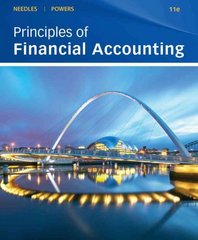Question
1.How are revenues and expenses recognized under the accrual basis of accounting? a. Revenues are recognized when cash is received and expenses are recognized when
1.How are revenues and expenses recognized under the accrual basis of accounting?
a. Revenues are recognized when cash is received and expenses are recognized when cash is paid.
b. Revenues and expenses are recognized equally over a twelve month period.
c. Revenues and expenses are recognized based on the choices of management.
d. Revenues are recognized in the accounting period when the sale is made and expenses are recognized in the period in which they relate to the sale of the product.
2.Where would you find the revenue of a company?
a. Balance sheet.
b. Income statement.
c. Statement of stockholders' equity.
d. Statement of cash flows.
e. Notes to the financial statements.
f. Auditor's report.
g. Management's discussion and analysis.
3.What types of information are necessary to evaluate a company but cannot be found in the financial statements?
4.How are marketable securities valued on the balance sheet?
a. Historical cost
b. At cost or fair value depending on how the securities are classified.
c. Market value.
d. At fair value with the difference between cost and fair value reported as revenue.
5.Which of the following would cause the recognition of a liability
a. Credit extended by suppliers.
b. Receipt of cash in advance for services.
c. Recognition of expense prior to the actual payment of cash.
d. All of the above.
6.If a firm chooses to use the FIFO method of inventory valuation instead of the LIFO method, explain the impact of deflation on the amounts shown on the balance sheet for inventory and on the income statement for cost of goods sold.
7.Why is the common-size income statement valuable to the analyst?
a. The common-size income statement shows the relative magnitude of revenues and expenses to total assets.
b. The common-size income statement allows the analyst to compare the firm to itself from year-to-year, but not to its competitors.
c. The common-size income statement shows the relative magnitude of revenues and expenses relative to profits.
d. The common-size income statement shows the relative magnitude of expenses relative to net sales.
8.What items should the analyst assess when analyzing the trend of a firm's sales number?
9.Explain how it is possible for a firm with a positive net profit to generate negative cash flow from operating activities.
10.What type of ratios measure the liquidity of specific assets and the efficiency of managing those assets?
a. Activity ratios.
b. Liquidity ratios.
c. Leverage ratios.
d. Profitability ratio
11.What relationship exists between the average collection period and accounts receivable turnover?
a. There is a direct and proportional relationship.
b. Both ratios are expressed in number of times receivables are collected per year.
c. Both ratios are expressed in number of days.
d. As average collection period increases (decreases) the accounts receivable turnover decreases (increases).
Question 12
A.What is the objective of financial statement analysis from the standpoint of a creditor?
B.What sources of information are available to creditors when analyzinga firm?
13.Explain in detail why it is important for ananalyst,especiallyanindividual considering an investment in a company, to consider an Industry Analysis when analyzing a company's financial statements.
14.Which of the following statements is false?
a.It is important to analyze operating expenses over which management exercises discretion and that have considerable impact on the firm's profitability.
b.Impairment charges do not need to be analyzed since they are generally a non-recurring expense.
c.Operating expenses should be tracked in terms of trends, absolute amounts, relationship to sales, and relationship to industry competitors
d.Operating expenses can be easily analyzed by preparing a common-size income statement.
15.How are revenues and expenses recognized under the accrual basis of accounting?
a.Revenues are recognized when cash is received and expenses are recognized when cash is paid.
b.Revenues and expenses are recognized equally over a twelve month period.
c.Revenues and expenses are recognized based on the choices of management.
d.Revenues are recognized in the accounting period when the sale is made and expenses are recognized in the period in which they relate to the sale of the product.
16.How would Accounts Payable be classified on the balance sheet?
a.Current assets.
b.Long-term assets.
c.Current liabilities.
d.Long-term liabilities.
e.Stockholders' equity.
17.Of what value is the calculation of gross profit margin?
a.The gross profit margin helps the analyst assess the capital structure of the firm.
b.Thegross profit margin allows the analyst to determine if the firm has been affected by inflation.
c.The gross profit margin indicates the profitability of a firm after considering all operating expenses.
d.The gross profit margin is the first step of profit measurement indicating how much profit the firm generates after deducting cost of goods sold.
18.What are three profit measures calculated from the income statement?
a.Operating profit margin, net profit margin, repairs and maintenance to fixed assets.
b.Gross profit margin, cost of goods sold percentage, EBIT.
c.Gross profit margin, operating profit margin, net profit margin.
d.None of the above.
19.Indicate where you would most likely find the information: Summary of significant accounting policies.
a.Balance sheet.
b.Income statement.
c.Statement of stockholders' equity.
d.Statement of cash flows.
e.Notes to the financial statements.
f.Auditor's report.
g.Management's discussion and analysis.
20.How would Equipment be classified on the balance sheet?
a.Current assets.
b.Long-term assets.
c.Current liabilities.
d.Long-term liabilities.
e.Stockholders' equity.
Step by Step Solution
There are 3 Steps involved in it
Step: 1

Get Instant Access to Expert-Tailored Solutions
See step-by-step solutions with expert insights and AI powered tools for academic success
Step: 2

Step: 3

Ace Your Homework with AI
Get the answers you need in no time with our AI-driven, step-by-step assistance
Get Started


